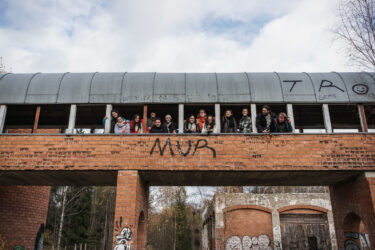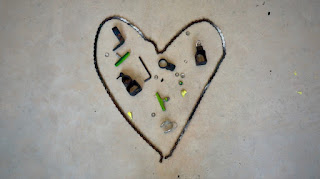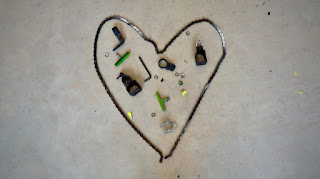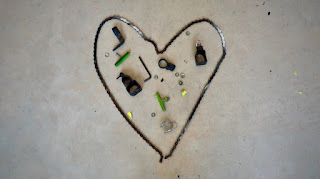Academic Affairs OfficeAccessory DesignAnimationArchitecture and Urban DesignArt EducationCenter for Flat TechnologiesCeramicsCultural Heritage and ConservationDepartmentsDesign and Technology FuturesDoctoral SchoolDrawingFacilities and WorkshopsFaculty of ArchitectureFaculty of Art and CultureFaculty of DesignFaculty of Fine ArtsFashion DesignFinancial DepartmentGalleryGlass ArtGraphic ArtGraphic DesignInstallation and SculptureInstitute of Art History and Visual CultureInternational OfficeIT OfficeJewellery and BlacksmithingLandscape ArchitectureLibraryLinnaehitus @enMaking SpaceNew MediaOffice of the RectorateOpen AcademyPaintingPerforming ArtsPhotographyProduct DesignRectorateResearch and Development OfficeScenographySupport UnitsTextile DesignUncategorizedUrban PlanningUrban Studies
Category: Urban Studies
04.05.2023
Common Futures
Faculty of Architecture
This year’s Urban studies Studio 2: Urban Futures explores the process of commoning as a social practice that radically rethinks property regimes and social relationships in order to envisage a ‘common future’: where despite our differences, we are all moving towards a collective and planetary future.
The final project for the studio sees students contribute to alternative ‘common futures’ through an architecture competition for a contemporary border crossing. The competition organised by The Canadian Academy of Architecture for Justice (CAAJ) “A New Frontier: The Contemporary Border Crossing” invites students to contribute to alternative common futures by designing a contemporary border crossing that can be ‘integrated into the surrounding context and community, act as a catalyst for building a positive relationship between two nations, and address what a border entry means in today’s context.’ The act of designing a border crossing requires students to rethink the prevailing ideas and imaginaries of how different states, communities and ecosocial assemblages are organised and how boundaries between them are defined. By exploring the legal and architectural forms that shape our societies, students can engage with the themes of commoning and contribute to the creation of alternative futures.
As a final outcome, student teams were asked to develop a specific design that answers the technical and conceptual requirements of the call. This includes creating two A1 posters and an accompanying 500-word description.
On 4th of May (A400,4th floor lobby) Students will introduce their projects at the final presentations followed by feedback and discussion.
Students: Aleyna Canpolat, Larisa Illetterati, Alp Ozalp, Ishrat Shaheen, Kalina.Trajanovska, Maria Laura Bendezu Ulloa, Jim Wolff.
Tutors: Agata Marzecova, Sean Tyler.
Guest critic: Klaske Havik
Posted by Keiti Kljavin — Permalink
Common Futures
Thursday 04 May, 2023
Faculty of Architecture
This year’s Urban studies Studio 2: Urban Futures explores the process of commoning as a social practice that radically rethinks property regimes and social relationships in order to envisage a ‘common future’: where despite our differences, we are all moving towards a collective and planetary future.
The final project for the studio sees students contribute to alternative ‘common futures’ through an architecture competition for a contemporary border crossing. The competition organised by The Canadian Academy of Architecture for Justice (CAAJ) “A New Frontier: The Contemporary Border Crossing” invites students to contribute to alternative common futures by designing a contemporary border crossing that can be ‘integrated into the surrounding context and community, act as a catalyst for building a positive relationship between two nations, and address what a border entry means in today’s context.’ The act of designing a border crossing requires students to rethink the prevailing ideas and imaginaries of how different states, communities and ecosocial assemblages are organised and how boundaries between them are defined. By exploring the legal and architectural forms that shape our societies, students can engage with the themes of commoning and contribute to the creation of alternative futures.
As a final outcome, student teams were asked to develop a specific design that answers the technical and conceptual requirements of the call. This includes creating two A1 posters and an accompanying 500-word description.
On 4th of May (A400,4th floor lobby) Students will introduce their projects at the final presentations followed by feedback and discussion.
Students: Aleyna Canpolat, Larisa Illetterati, Alp Ozalp, Ishrat Shaheen, Kalina.Trajanovska, Maria Laura Bendezu Ulloa, Jim Wolff.
Tutors: Agata Marzecova, Sean Tyler.
Guest critic: Klaske Havik
Posted by Keiti Kljavin — Permalink
26.01.2023
To walk a secant line (?) – Athens meets Tallinn; Tallinn meets Athens
Erasmus+
If two points on a circle are a map, a secant line establishes a relationship between the points as two places, connecting them spatially and interrogating their position with respect to each other, juxtaposing them.
After spending three weeks in Athens Estonian Academy of Arts urban studies, animation, architecture, fine arts and graphic design students propose to connect the two geographical locations, Athens and Tallinn, by starting to walk and test the bridging line between two peripheries rarely thought together in the European context.
What is the Union between these geographically so distant cities? How do they feel when experienced side by side, when one melts into the other and vice versa? Can we learn more about the circle by looking at the two points simultaneously?
Join them online: http://urbanisms-of-migration.hotglue.me/ as they walk the two cityscapes together, digging a interactive “hole” into the (dis)common ground of two capitals on the EU’s southern and northeastern borders.
The event is hosted by MA-students of the first ever student-led course of the Estonian Academy of Arts, Tallinn, in collaboration with Communitism, Athens.
Students: Viktor Kudriashov, Diana Drobot, Paul Simon, Luca Liese Ritter, Nabeel Imtiaz, Sachal Rizvi, Christian Hörner, Inês Machado Sales Grade Pinto, Aurelijus Čiupas, Pietro Ercolino Vizzardelli Barcucci, Siew Ching An, Kaja Likar.
Communitism: https://communitism.space/
Student-lead course “Urbanisms of Migration: Researching the Periphery of the European Union” is supervised by Urban studies second year students:
Blog: https://padlet.com/urbanperipheries/athens
Posted by Keiti Kljavin — Permalink
To walk a secant line (?) – Athens meets Tallinn; Tallinn meets Athens
Thursday 26 January, 2023
Erasmus+
If two points on a circle are a map, a secant line establishes a relationship between the points as two places, connecting them spatially and interrogating their position with respect to each other, juxtaposing them.
After spending three weeks in Athens Estonian Academy of Arts urban studies, animation, architecture, fine arts and graphic design students propose to connect the two geographical locations, Athens and Tallinn, by starting to walk and test the bridging line between two peripheries rarely thought together in the European context.
What is the Union between these geographically so distant cities? How do they feel when experienced side by side, when one melts into the other and vice versa? Can we learn more about the circle by looking at the two points simultaneously?
Join them online: http://urbanisms-of-migration.hotglue.me/ as they walk the two cityscapes together, digging a interactive “hole” into the (dis)common ground of two capitals on the EU’s southern and northeastern borders.
The event is hosted by MA-students of the first ever student-led course of the Estonian Academy of Arts, Tallinn, in collaboration with Communitism, Athens.
Students: Viktor Kudriashov, Diana Drobot, Paul Simon, Luca Liese Ritter, Nabeel Imtiaz, Sachal Rizvi, Christian Hörner, Inês Machado Sales Grade Pinto, Aurelijus Čiupas, Pietro Ercolino Vizzardelli Barcucci, Siew Ching An, Kaja Likar.
Communitism: https://communitism.space/
Student-lead course “Urbanisms of Migration: Researching the Periphery of the European Union” is supervised by Urban studies second year students:
Blog: https://padlet.com/urbanperipheries/athens
Posted by Keiti Kljavin — Permalink
18.12.2022
art and the city
Architecture and Urban Design
“Art and the City” – a live action play in Telliskivi Creative City – is inviting you to come and enquire what art and creativity do in a modern capitalist city. How is creativity and art used to make cities of today, who is the creative class and how can one enter the creative city?
Urban studies and architecture students of EKA address the questions revolving around the role of creativity in a city via an immersive role play, inviting the player to see Telliskivi Creative City through seven different characters’ eyes. How would a retired worker of the former factory see the place today, when the citadelle of a secret factory with its monotonous work has been opened up into a diverse creative village with no walls around? How is it to be an artist in a gallery that doesn’t any more represent the value of art space as a critical force or antithesis but rather acts as a tiny particle in a greater creative soup? Or how could a young designer who recently moved to Estonia enter the area as a creative workforce, not merely a consumer? Etc, etc.
If you’re ready to play, meet us in Telliskivi on Sunday, 18. December between 12 and 3 PM. Come and win with us: there will be wonderful prizes for the best players!
Posted by Keiti Kljavin — Permalink
art and the city
Sunday 18 December, 2022
Architecture and Urban Design
“Art and the City” – a live action play in Telliskivi Creative City – is inviting you to come and enquire what art and creativity do in a modern capitalist city. How is creativity and art used to make cities of today, who is the creative class and how can one enter the creative city?
Urban studies and architecture students of EKA address the questions revolving around the role of creativity in a city via an immersive role play, inviting the player to see Telliskivi Creative City through seven different characters’ eyes. How would a retired worker of the former factory see the place today, when the citadelle of a secret factory with its monotonous work has been opened up into a diverse creative village with no walls around? How is it to be an artist in a gallery that doesn’t any more represent the value of art space as a critical force or antithesis but rather acts as a tiny particle in a greater creative soup? Or how could a young designer who recently moved to Estonia enter the area as a creative workforce, not merely a consumer? Etc, etc.
If you’re ready to play, meet us in Telliskivi on Sunday, 18. December between 12 and 3 PM. Come and win with us: there will be wonderful prizes for the best players!
Posted by Keiti Kljavin — Permalink
30.01.2023
Urban Studies MSc programme online info session
Urban Studies
EKA Urban Studies MSc programme invites prospective master’s students to join the programme’s online info session on Monday, January 30, 2023 at 16:00 EET (local Estonian time).
This online info session will be a good opportunity to hear more about the curriculum, and to meet and ask questions directly from people behind Urban Studies programme. The info session will be hosted online over Zoom.
If you would like to attend, please register online through the form below. A link to attend will be e-mailed shortly before the event begins.
REGISTER HERE
More information about Urban Studies MSc programme:
Next admissions period starts on the 1st of February 2023 and application deadline is 6th of March 2023.
Posted by Maarja Pabut — Permalink
Urban Studies MSc programme online info session
Monday 30 January, 2023
Urban Studies
EKA Urban Studies MSc programme invites prospective master’s students to join the programme’s online info session on Monday, January 30, 2023 at 16:00 EET (local Estonian time).
This online info session will be a good opportunity to hear more about the curriculum, and to meet and ask questions directly from people behind Urban Studies programme. The info session will be hosted online over Zoom.
If you would like to attend, please register online through the form below. A link to attend will be e-mailed shortly before the event begins.
REGISTER HERE
More information about Urban Studies MSc programme:
Next admissions period starts on the 1st of February 2023 and application deadline is 6th of March 2023.
Posted by Maarja Pabut — Permalink
06.12.2022
NO-THING: Theories and Urbanisms of the Void
Faculty of Architecture
Final review and zine launch
Welcome to the final review and launch of NO-ZINE #1: This is Not a Pizza, the final project of the Urban Studies studio NO-THING: Theories and Urbanisms of the Void.
The research studio critically examines the narratives of potentials and resistance that accompany the gaps, voids and wastelands of the city. Though the void at the heart of urban space appears to hold the promise of something public, shared and democratic, its “nothingness” also serves as a fertile ground for speculation. What might the contemporary valorization of nothing hold from the perspective that nothing is, in fact, something? Weaving science fiction, fake bootlegs, counterfeit ads, GAN prompts, and essays about entrepreneurs, swimming pools, and market stalls, NO-ZINE #1 investigates the contemporary city through the lens of its perceived other—its emptiness—to examine the processes and forces that shape the city today.
The final review will be followed by the launch of NO-ZINE #1: This Is Not a Pizza. A limited number of copies will be available for distribution.
Students: Christian Hörner, Jarþrúður Iða, Nabeel Imtaz, Carl-Magnus Meijer, Luca Ritter, Paul Simon, Nora Soo, Paula Viedenbauma
Final Critics: Maroš Krivý and Bettina Schwalm
Course tutors: Leonard Ma and Helen Runting
Graphic design support: Oliver Long
Posted by Andres Lõo — Permalink
NO-THING: Theories and Urbanisms of the Void
Tuesday 06 December, 2022
Faculty of Architecture
Final review and zine launch
Welcome to the final review and launch of NO-ZINE #1: This is Not a Pizza, the final project of the Urban Studies studio NO-THING: Theories and Urbanisms of the Void.
The research studio critically examines the narratives of potentials and resistance that accompany the gaps, voids and wastelands of the city. Though the void at the heart of urban space appears to hold the promise of something public, shared and democratic, its “nothingness” also serves as a fertile ground for speculation. What might the contemporary valorization of nothing hold from the perspective that nothing is, in fact, something? Weaving science fiction, fake bootlegs, counterfeit ads, GAN prompts, and essays about entrepreneurs, swimming pools, and market stalls, NO-ZINE #1 investigates the contemporary city through the lens of its perceived other—its emptiness—to examine the processes and forces that shape the city today.
The final review will be followed by the launch of NO-ZINE #1: This Is Not a Pizza. A limited number of copies will be available for distribution.
Students: Christian Hörner, Jarþrúður Iða, Nabeel Imtaz, Carl-Magnus Meijer, Luca Ritter, Paul Simon, Nora Soo, Paula Viedenbauma
Final Critics: Maroš Krivý and Bettina Schwalm
Course tutors: Leonard Ma and Helen Runting
Graphic design support: Oliver Long
Posted by Andres Lõo — Permalink
06.12.2022
Urban Studies to Host Non-Zine Launch
Urban Studies
Urban Studies will host a zine launch on Tuesday, December 6th at 7 p.m., presenting the final outcome of Urban Studies’ Studio 3.
This semester, the students of the second year of Urban Studies have been dealing with the theme of “urban nothing”. What disappeared in this case is “the pizza from the box”, and a non-zine has been materialised, featuring individual contributions, inspired by various urban voids.
To celebrate the last studio ever of MUR21, Urban Studies Department is hosting a launch event to give everyone a taste.
The boxes will be the first to inhabit the new “EKA Zine Library” – if you have any laying around that you might wanna add to the archive, bring it with you.
Studio 3 was taught by Helen Runting and Leonard Ma.
Contributions by Nora Soo, Paul Simon, Jarþrúður Iða, Nabeel Imtiaz, Luca Liese Ritter, Christian Hörner, Carl-Magnus Meijer, Paula Veidenbauma
Posted by Andres Lõo — Permalink
Urban Studies to Host Non-Zine Launch
Tuesday 06 December, 2022
Urban Studies
Urban Studies will host a zine launch on Tuesday, December 6th at 7 p.m., presenting the final outcome of Urban Studies’ Studio 3.
This semester, the students of the second year of Urban Studies have been dealing with the theme of “urban nothing”. What disappeared in this case is “the pizza from the box”, and a non-zine has been materialised, featuring individual contributions, inspired by various urban voids.
To celebrate the last studio ever of MUR21, Urban Studies Department is hosting a launch event to give everyone a taste.
The boxes will be the first to inhabit the new “EKA Zine Library” – if you have any laying around that you might wanna add to the archive, bring it with you.
Studio 3 was taught by Helen Runting and Leonard Ma.
Contributions by Nora Soo, Paul Simon, Jarþrúður Iða, Nabeel Imtiaz, Luca Liese Ritter, Christian Hörner, Carl-Magnus Meijer, Paula Veidenbauma
Posted by Andres Lõo — Permalink
13.10.2022
Open lecture of architecture: Marvin Bratke, Berlin
Architecture and Urban Design
Warum Berlin?
We continue digging into Berlin’s architectural landscape. What is being done in this city, which architecture offices operate in Berlin, what is being built and what is being thought about: the series of open architecture lectures of the EKA Faculty of Architecture will travel to the capital of Germany and one of the most colourful metropolises in Europe this fall, with architects from Berlin as guests.
According to the curator of the lecture program, Johan Tali, Berlin is loaded. On the one hand, due to its tragic past, the wounds of which have to be dealt with in the urban space until now. On the other hand, hundreds of communities with different cultures gather in Berlin, and the result is one of the largest cultural compotes in Europe.
On October 13, architect, entrepreneur and spatial innovation studio Urban Beta and co-founder of the architectural firm Bart // Bratke Marvin Bratke will be on stage with a lecture “Circular Futures. Architecture for a Post-Growth Society”.
Bart // Bratke is a research and architecture studio based in London and Berlin, founded to create visions of future mobility and architectural research touchpoints. They realize their multidisciplinary and functional concepts in planning versatile spaces of the future. Urban Beta offers technological solutions for carbon-negative modular system buildings included in the circular economy.
The open lectures are intended for students and professionals of all disciplines – not just the field of architecture. All lectures take place in the large auditorium of EKA, are in English, free of charge and open to all interested parties.
Every academic year, the Department of Architecture and Urban Planning of EKA brings to the audience in Tallinn about a dozen unique practitioners and valued theoreticians of the field. You can watch previous years’ lectures on YouTube and www.avatudloengud.ee
The lecture series is supported by the Cultural Endowment of Estonia.
Curator: Johan Tali
Posted by Andres Lõo — Permalink
Open lecture of architecture: Marvin Bratke, Berlin
Thursday 13 October, 2022
Architecture and Urban Design
Warum Berlin?
We continue digging into Berlin’s architectural landscape. What is being done in this city, which architecture offices operate in Berlin, what is being built and what is being thought about: the series of open architecture lectures of the EKA Faculty of Architecture will travel to the capital of Germany and one of the most colourful metropolises in Europe this fall, with architects from Berlin as guests.
According to the curator of the lecture program, Johan Tali, Berlin is loaded. On the one hand, due to its tragic past, the wounds of which have to be dealt with in the urban space until now. On the other hand, hundreds of communities with different cultures gather in Berlin, and the result is one of the largest cultural compotes in Europe.
On October 13, architect, entrepreneur and spatial innovation studio Urban Beta and co-founder of the architectural firm Bart // Bratke Marvin Bratke will be on stage with a lecture “Circular Futures. Architecture for a Post-Growth Society”.
Bart // Bratke is a research and architecture studio based in London and Berlin, founded to create visions of future mobility and architectural research touchpoints. They realize their multidisciplinary and functional concepts in planning versatile spaces of the future. Urban Beta offers technological solutions for carbon-negative modular system buildings included in the circular economy.
The open lectures are intended for students and professionals of all disciplines – not just the field of architecture. All lectures take place in the large auditorium of EKA, are in English, free of charge and open to all interested parties.
Every academic year, the Department of Architecture and Urban Planning of EKA brings to the audience in Tallinn about a dozen unique practitioners and valued theoreticians of the field. You can watch previous years’ lectures on YouTube and www.avatudloengud.ee
The lecture series is supported by the Cultural Endowment of Estonia.
Curator: Johan Tali
Posted by Andres Lõo — Permalink
30.05.2022
Urban Studies Master’s Thesis Presentation and Defence
Urban Studies
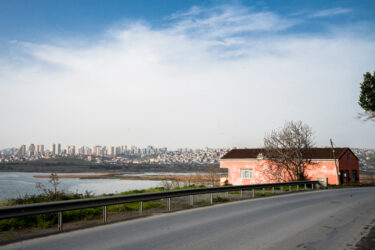
10:00-10:10 Introductions
10:10-11:10 (EEST)
Luisa Fernanda Ayla Torres
Precariousness in the Transformation of Labour: Through Working Class Identity in the city of Turin
Between the 1960s and 1980s, nine million Italians migrated from the agricultural regions of Italy to the productive areas of Turin, shaping the periphery of the city from a rural to an industrial area. The Post-War economic boom provided jobs in the northern plants, giving life to a workers’ hegemony and demographic, social, and cultural transformation. This socioeconomic transformation that affected the organisation of workers, labour, political activity, and society in general, was manifested in two cases. The Palace of Labour, an avant-garde building intended to celebrate the struggles of the working class with an exhibition focused on “man and his progress”, and the case of Mirafiori Sud, a working class neighbourhood symbolising the association of workers. In this way, this thesis explores the identity of the working class in the contemporary city of Turin, where security in neoliberal times no longer needs the scope of the protective techniques of the liberal social State, and as a consequence precarization is now the norm. This is reflected in the transformation of labour manifesting itsel through productive connection with others, where labour is not purely characterised by the increasing capitalization of social life but is effectively reflected with others, producing new social relations.
Examined by Alberto Vanolo (University of Turin) and Aro Velmet (University of Southern California)
11.15-12:15 (EEST)
Mira Samonig
the matter of right-wing populism in Polish LGBT-free zones; towards a with-standing xenourbanism?
Almost a third of Poland had been declared an ‘LGBT-free zone’ in 2020, stigmatizing the LGBTIQP+ community as a threat to Polish identity; this labeling remains a reality for many Polish towns. In this thesis, I am turning towards the concept of the ‘LGBT-free zones’ as a case to investigate the material reality of right-wing populism. I seek to develop a third position to a historical or new materialist understanding in order to investigate such material reality. By that, the ways values find physical expression and thus possibly mobilize oppressive attitudes into ever new futures ahead are traced. It becomes quite evident that the way structures of oppression are advanced and maintained within the public realm exists quite dominantly in everyday narratives. In a bottom-up manner, right-wing populism is advanced on the street; yet, it is by far not perceived by everyone. This marks the entry point for sketching out a possible approach to how the discipline of urbanism could position itself in social struggles. Drawing on Helen Hester’s Xenofeminism, the thesis introduces the concept of xenourbanism describing urbanism based on the conceptual notion of solidarity without sameness. I argue that the notion of xeno- as a prefix attached to urbanism focuses on an inherent transformational potential within the current, rendering a perceived unarming reality into a weapon of contestation and by that suggesting trajectories away from paralyzing no-alternative narratives.
Examined by Piotr Plucienniczak (Warsaw Academy of Fine Arts) and Helen Runting (Secretary)
12:25-13:35 (EEST)
Zahaan Khan
Tourism-Led Gentrification: The Case of Dal Lake in Kashmir
The dissertation explores tourism-led gentrification, its causes and the impact on the communities living in and around the ecologically-sensitive region of Dal Lake in Kashmir. The dissertation employs methodological triangulation using interviews, survey and policy document analysis, as methods. The policy document in question is the Srinagar Master Plan 2035 issued by the Srinagar Development Authority. Analysing the correlation between tourism and gentrification in a conflict-torn region and using displacement as a conceptual lens, the thesis maps the socio-cultural and economic aspects of touristification especially in relation to the everyday lives of the communities. The dissertation employs a two-pronged analytical approach by using two categories – land milieu and water milieu – to foreground the patterns and impact of gentrification in and around the lake. The analysis of the land milieu concerns itself with a detailed exploration into Boulevard, the long promenade along the lake’s periphery. It further discusses holiday rentals and issues of mobility and maps the city’s land-use patterns particularly in relation to expansion along the lake’s periphery. The study of the water milieu, on the other hand, is an exploration into the historical houseboats of Kashmir and the local hanji (or haenz) community; foregrounding the issues concerning policies of renovation and relocation of
houseboats. The dissertation also delves into the government’s land use and tourism-driven development plans around the lake, especially post abrogation of
Article 370 of the Indian constitution that gave ‘special status’ to the region.
Examined by Dr Mathew Varghese (Mahatma Gandhi University) and Karlis Ratnieks (EKA)
13:35-14:25 Lunch
14:25-15:25 (EEST)
Egemen Mercanlioglu
THE WORK OF A RIFT: Kanal İstanbul and Turkey’s Authoritarian Neoliberalism
Turkey under the leadership of Recep Tayyip Erdoğan and his Adalet ve Kalkınma Partisi was touted as a paragon of neoliberalism and a burgeoning democracy until the late-2000s. Two decades later, the positive portrayals of the country have decidedly shifted. Turkey is now considered to have retreated from neoliberalism; an emblematic case of authoritarian turn. However, this thesis rethinks authoritarian governance as the kernel of the Erdoğan-led AKP’s brand of neoliberalism. It does so by focusing on a to-be-built urban megaproject, Kanal İstanbul—a 45-kilometer long man-made waterway, aiming to locate İstanbul as a signature node in the global web of flooding money and commodities. Using the megaproject as a lens, the thesis shows how neoliberal reforms in the early-2000s have propelled İstanbul and the construction sector as financial growth generating engines of the country. Subsequently, these
reforms have buttressed contemporary coercive governance structure and a megaproject spree in the city. Finally, the thesis briefly explores a recent but growing counter-hegemonic contestation against Erdoğan and his Kanal İstanbul, posed by the mayor of İstanbul. The thesis does not give a final verdict but explores whether or not this challenge proposes an alternative to authoritarian neoliberalism.
Examined by Dr Cemal Burak Tansel (Newcastle University) and Mattias Malk (EKA)
15:30-16:30 (EEST)
Deniz Taskin
Architecture as a Practice of Care: Case Studies of Women’s Care-Based Architecture Practices
Care as a concept is becoming more crucial in architecture and urban practice as a result of
the COVID-19 pandemic’s unpredictable spatial, social, and political circumstances. The
attitude of urbanized capitalism towards contemporary urban problems and its refusal to
acknowledge the urgency of the climate crisis result in uncaring urban practices. The
important position of architecture as a measure for assessing our place in the ecosystem and
the role of architects and related disciplines in determining with whom we live together
requires them to reconsider the values and priorities that drive their practice.
This thesis unpacks care as a concept and ethical practice through a feminist lens by
focusing on the notion of “configuration of care,” which refers to how architects express their
ethical and political objectives by arranging human and nonhuman materials to achieve
caring relationships in urban spaces. (Suchman 2012). It does so by focusing on the practices
of women from the field of architecture and related disciplines whose contemporary practice
foregrounds care and employs feminist care ethics: Careful Mapping by Spolka, Performing
Architherapy by Erika Henriksson, Mutfak (Kitchen) by Merve Bedir, The Blind Alley by
Elin Strand Ruin. The thesis explores certain commonalities and recurring patterns of thought
in how the practitioners’ encounter and apply feminist care ethics. Finally, it discusses the
potential and limits of incorporating feminist care ethics into architecture practice, as well as
the potential for architectural practice to become care practice.
Examined by Agata Marzecova (EKA) and Henriette Steiner (University of Copenhagen)
Posted by Kaija-Luisa Kurik — Permalink
Urban Studies Master’s Thesis Presentation and Defence
Monday 30 May, 2022
Urban Studies

10:00-10:10 Introductions
10:10-11:10 (EEST)
Luisa Fernanda Ayla Torres
Precariousness in the Transformation of Labour: Through Working Class Identity in the city of Turin
Between the 1960s and 1980s, nine million Italians migrated from the agricultural regions of Italy to the productive areas of Turin, shaping the periphery of the city from a rural to an industrial area. The Post-War economic boom provided jobs in the northern plants, giving life to a workers’ hegemony and demographic, social, and cultural transformation. This socioeconomic transformation that affected the organisation of workers, labour, political activity, and society in general, was manifested in two cases. The Palace of Labour, an avant-garde building intended to celebrate the struggles of the working class with an exhibition focused on “man and his progress”, and the case of Mirafiori Sud, a working class neighbourhood symbolising the association of workers. In this way, this thesis explores the identity of the working class in the contemporary city of Turin, where security in neoliberal times no longer needs the scope of the protective techniques of the liberal social State, and as a consequence precarization is now the norm. This is reflected in the transformation of labour manifesting itsel through productive connection with others, where labour is not purely characterised by the increasing capitalization of social life but is effectively reflected with others, producing new social relations.
Examined by Alberto Vanolo (University of Turin) and Aro Velmet (University of Southern California)
11.15-12:15 (EEST)
Mira Samonig
the matter of right-wing populism in Polish LGBT-free zones; towards a with-standing xenourbanism?
Almost a third of Poland had been declared an ‘LGBT-free zone’ in 2020, stigmatizing the LGBTIQP+ community as a threat to Polish identity; this labeling remains a reality for many Polish towns. In this thesis, I am turning towards the concept of the ‘LGBT-free zones’ as a case to investigate the material reality of right-wing populism. I seek to develop a third position to a historical or new materialist understanding in order to investigate such material reality. By that, the ways values find physical expression and thus possibly mobilize oppressive attitudes into ever new futures ahead are traced. It becomes quite evident that the way structures of oppression are advanced and maintained within the public realm exists quite dominantly in everyday narratives. In a bottom-up manner, right-wing populism is advanced on the street; yet, it is by far not perceived by everyone. This marks the entry point for sketching out a possible approach to how the discipline of urbanism could position itself in social struggles. Drawing on Helen Hester’s Xenofeminism, the thesis introduces the concept of xenourbanism describing urbanism based on the conceptual notion of solidarity without sameness. I argue that the notion of xeno- as a prefix attached to urbanism focuses on an inherent transformational potential within the current, rendering a perceived unarming reality into a weapon of contestation and by that suggesting trajectories away from paralyzing no-alternative narratives.
Examined by Piotr Plucienniczak (Warsaw Academy of Fine Arts) and Helen Runting (Secretary)
12:25-13:35 (EEST)
Zahaan Khan
Tourism-Led Gentrification: The Case of Dal Lake in Kashmir
The dissertation explores tourism-led gentrification, its causes and the impact on the communities living in and around the ecologically-sensitive region of Dal Lake in Kashmir. The dissertation employs methodological triangulation using interviews, survey and policy document analysis, as methods. The policy document in question is the Srinagar Master Plan 2035 issued by the Srinagar Development Authority. Analysing the correlation between tourism and gentrification in a conflict-torn region and using displacement as a conceptual lens, the thesis maps the socio-cultural and economic aspects of touristification especially in relation to the everyday lives of the communities. The dissertation employs a two-pronged analytical approach by using two categories – land milieu and water milieu – to foreground the patterns and impact of gentrification in and around the lake. The analysis of the land milieu concerns itself with a detailed exploration into Boulevard, the long promenade along the lake’s periphery. It further discusses holiday rentals and issues of mobility and maps the city’s land-use patterns particularly in relation to expansion along the lake’s periphery. The study of the water milieu, on the other hand, is an exploration into the historical houseboats of Kashmir and the local hanji (or haenz) community; foregrounding the issues concerning policies of renovation and relocation of
houseboats. The dissertation also delves into the government’s land use and tourism-driven development plans around the lake, especially post abrogation of
Article 370 of the Indian constitution that gave ‘special status’ to the region.
Examined by Dr Mathew Varghese (Mahatma Gandhi University) and Karlis Ratnieks (EKA)
13:35-14:25 Lunch
14:25-15:25 (EEST)
Egemen Mercanlioglu
THE WORK OF A RIFT: Kanal İstanbul and Turkey’s Authoritarian Neoliberalism
Turkey under the leadership of Recep Tayyip Erdoğan and his Adalet ve Kalkınma Partisi was touted as a paragon of neoliberalism and a burgeoning democracy until the late-2000s. Two decades later, the positive portrayals of the country have decidedly shifted. Turkey is now considered to have retreated from neoliberalism; an emblematic case of authoritarian turn. However, this thesis rethinks authoritarian governance as the kernel of the Erdoğan-led AKP’s brand of neoliberalism. It does so by focusing on a to-be-built urban megaproject, Kanal İstanbul—a 45-kilometer long man-made waterway, aiming to locate İstanbul as a signature node in the global web of flooding money and commodities. Using the megaproject as a lens, the thesis shows how neoliberal reforms in the early-2000s have propelled İstanbul and the construction sector as financial growth generating engines of the country. Subsequently, these
reforms have buttressed contemporary coercive governance structure and a megaproject spree in the city. Finally, the thesis briefly explores a recent but growing counter-hegemonic contestation against Erdoğan and his Kanal İstanbul, posed by the mayor of İstanbul. The thesis does not give a final verdict but explores whether or not this challenge proposes an alternative to authoritarian neoliberalism.
Examined by Dr Cemal Burak Tansel (Newcastle University) and Mattias Malk (EKA)
15:30-16:30 (EEST)
Deniz Taskin
Architecture as a Practice of Care: Case Studies of Women’s Care-Based Architecture Practices
Care as a concept is becoming more crucial in architecture and urban practice as a result of
the COVID-19 pandemic’s unpredictable spatial, social, and political circumstances. The
attitude of urbanized capitalism towards contemporary urban problems and its refusal to
acknowledge the urgency of the climate crisis result in uncaring urban practices. The
important position of architecture as a measure for assessing our place in the ecosystem and
the role of architects and related disciplines in determining with whom we live together
requires them to reconsider the values and priorities that drive their practice.
This thesis unpacks care as a concept and ethical practice through a feminist lens by
focusing on the notion of “configuration of care,” which refers to how architects express their
ethical and political objectives by arranging human and nonhuman materials to achieve
caring relationships in urban spaces. (Suchman 2012). It does so by focusing on the practices
of women from the field of architecture and related disciplines whose contemporary practice
foregrounds care and employs feminist care ethics: Careful Mapping by Spolka, Performing
Architherapy by Erika Henriksson, Mutfak (Kitchen) by Merve Bedir, The Blind Alley by
Elin Strand Ruin. The thesis explores certain commonalities and recurring patterns of thought
in how the practitioners’ encounter and apply feminist care ethics. Finally, it discusses the
potential and limits of incorporating feminist care ethics into architecture practice, as well as
the potential for architectural practice to become care practice.
Examined by Agata Marzecova (EKA) and Henriette Steiner (University of Copenhagen)
Posted by Kaija-Luisa Kurik — Permalink
19.05.2022
“Preservation: Architecture, Nature and Politics” studio final presentations in Pärnu
Urban Studies
Preservation has achieved cultural significance as a lens through which various urban experts have come
to imagine what a socially and environmentally sound future might look like. As an approach, preservation has been applied to disparate phenomena ranging from historic neighbourhoods and natural environments to democracy and identity. This studio unfolded the formative concepts and historic moments that define contemporary understandings of preservation and applied these discussions to various typologies of architecture, urban fabric and the natural environment taking Pärnu and the wider region as a case study. In particular, the studio focused on the ways in which ideas, labour and design have intersected in the past to identify alternatives to the mainstream forms of preservation.
The studio culminates with a presentation of group projects that explore a variety of approaches to layers of heritage and questions of preservation in Pärnu and Sindi. Pärnu, the fourth largest city in Estonia, is struggling with the seemingly conflicting and contradictory notions of growth, shrinkage, preservation and destruction. Sindi, as a smaller town in the region, faces similar, but also additional challenges connected to its significant industrial heritage. Efforts to imagine and construct a vision for a city are also tied up with the tactile practices of preservation; set within specific administrative and management frameworks of maintenance, care, and neglect.
Despite intentions, prescriptive visions by the city and developers can serve to exacerbate inequalities through the various infrastructures, supply chains, policies and environmental conditions that extend well beyond the rigid borders of a city.
Can the concept of preservation open a discussion around a vision for Pärnu (and its hinterlands)
beginning not with growth and progress, but rather with repair, maintenance or even deterioration?
Student projects explore who gets to decide what is valuable, organise the preservation of things, and who then carries out the work. Negotiations about what should be preserved and what “good preservation” entails, are always contingent and contextual.
Projects:
-
- Decompressed Transition: Paula Veidenbauma, Nora Soo and Jannik Kastrup
- Tides of a Summer City: Khadeeja Farrukh, Anna Dzebliuk and Christian Hörner
- Fabricated Heritage – Interweaving the Past and Future of Sindi’s Kalevivabrik: Luca Riese Ritter, Paulina Schroeder and Augustas Lapinskas
- Tea, Coffee or Hot Water?: What to Make of the Boiler Room: Kush Badhwar, Nabeel Imtiaz and Paul Simon
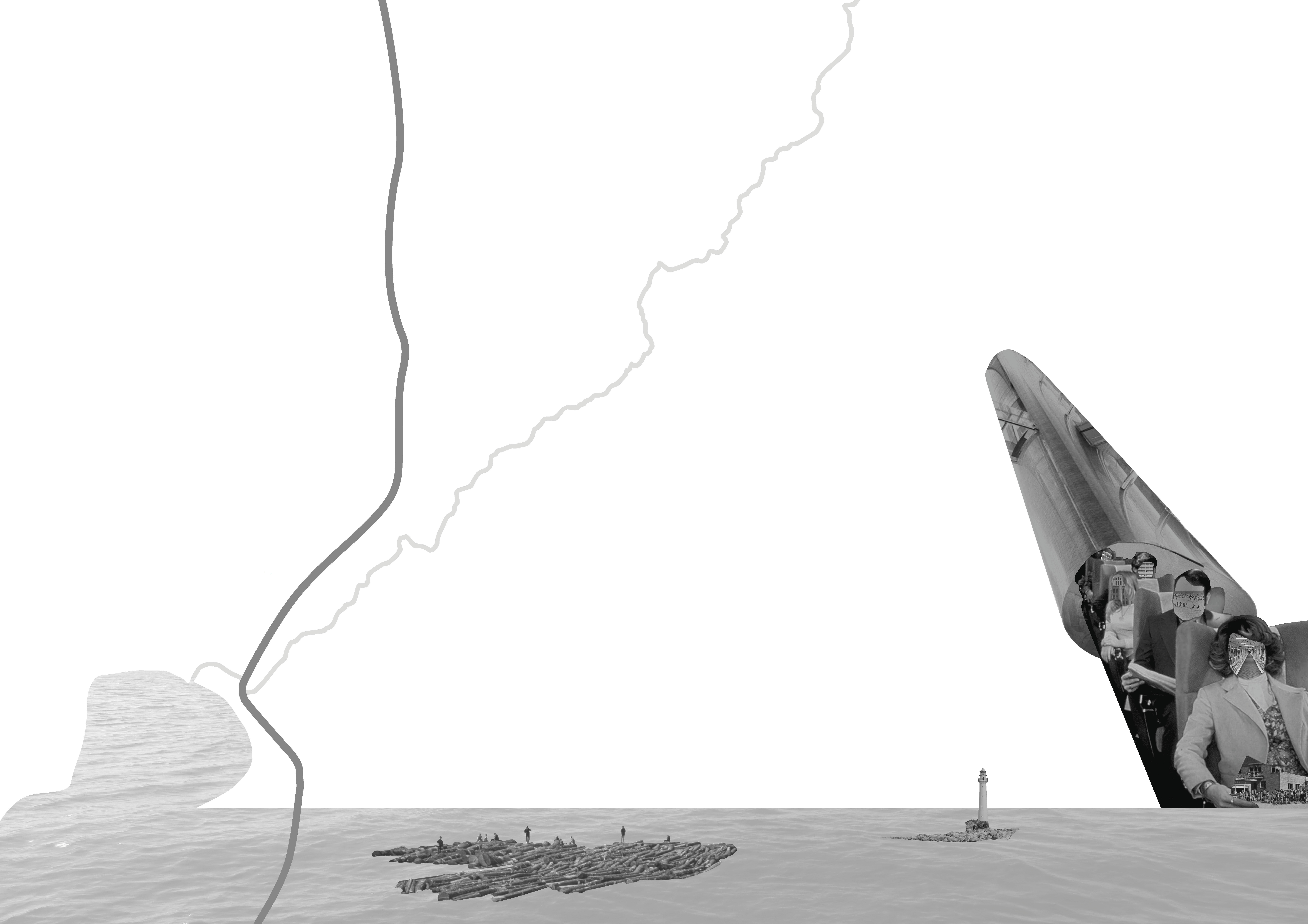 Decompressed Transition
Decompressed Transition
Paula Veidenbauma, Nora Soo and Jannik Kastrup
Pärnu is caught between diverging time regimes. In its role as a major spa and resort town, the city aims at slowing down the rhythm of life of the urban workforce. In parallel, the developments surrounding Rail Baltica will likely greatly compress this rhythm within Pärnu. The project examines frameworks of the relationship between those phenomena. It deals with instances of built and immaterial heritage and acts of preserving, especially the latter through shifting political systems. The float, emerging as the central piece of the project, can be interpreted as a gradient operating between Rail Baltica (a linear and high-velocity infrastructure), Pärnu’s leisure facilities and the open sea. It might function as a means of transportation while also exploring the possibility of non-arrival.
Visitors will be engaging with the project via a video installation, a float building workshop and a presentation. Float building instructions will be summarised in a booklet.
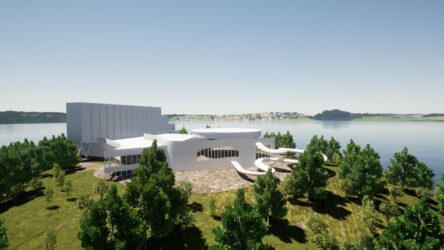 Tides of a Summer City
Tides of a Summer City
Khadeeja Farrukh, Anna Dzebliuk and Christian Hörner
The project explores possible resilient futures in Pärnu as a resort city. Showing how the “Summer City” developed historically, the video installation extrapolates empirical insights through Pärnu’s present-day reality into a future of constant flood emergency. The installation mobilizes futuristic renderings of possible resilient futures after a catastrophic flooding event to juxtapose and question the concepts of heritage, seasonality and resilience. We touch upon the inter-urban dependencies between Pärnu and Tallinn, manifesting historically, materially and spatially at the seaside of Estonia’s summer capital, securing the cities influx of holidaymakers during summer, but also causing issues of urban disenfranchisement of its residents, exploitation of its workers and destruction of coastal habitats of non-human residents. Looking into the future, it will no longer be possible to brush over the threat of flooding and the prospect of permanent crisis. The project “Tides of a Summer City” asks hypothetical questions, working towards a framework for understanding future challenges by following the changing historical tides of a summer city.
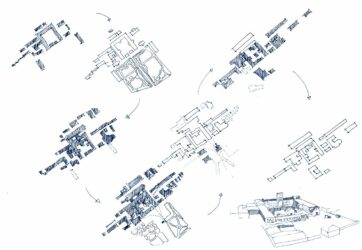
Fabricated Heritage – Interweaving the Past and Future of Sindi’s Kalevivabrik
Luca Riese Ritter, Paulina Schroeder and Augustas Lapinskas
The project explores the significance of Sindi´s industrial heritage. In recent decades, globalisation, deindustrialization, economic restructuring and industrial relocation have produced new landscapes within many European cities and towns – the post-industrial landscape. Deprived of their raison d’être, they are often regarded as spatially, socially, and semiotically empty places. In order to overcome this apparent ‘void’, the transformation of these post-industrial remnants into new uses is now an essential part of urban development practice.
Turning to industrial landscapes as potential carriers of cultural heritage ostensibly provides a framework for the continued management of these sites. Industrial heritage then becomes the bearer of local identity and creates uniqueness out of the former mundane.
The town of Sindi, a place essentially born from the settlement of a textile factory in the early 19th century, is in the process of discussing the reintegration of the material remains of industrial production into the town’s fabric which, since the closure of Kalevivabrik, the textile factory, has outgrown its original purpose. In this process of readjusting the relationship between factory-gone-ruin and the reorientation of the city, our project seeks to understand the potentials and conflicts that arise from industrial heritage, while taking a critical perspective at the practices of heritage preservation and its political implications. How and by whom is the town’s history preserved and remembered? Can there be a value of the material remains in the process of their decay? What is the role of heritage as a legal imperative? What role can the factory building play in the future of Sindi?
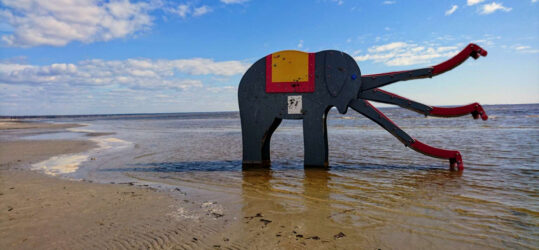 Tea, Coffee or Hot Water?: What to Make of the Boiler Room
Tea, Coffee or Hot Water?: What to Make of the Boiler Room
Kush Badhwar, Nabeel Imtiaz and Paul Simon
Drawing on the interest in the role of the educational institution Academia Non-Grata, elephants and other far-out references, the project explores junctions between the plan, the script and performance; preservation, the boiler room in the wider fabric of Pärnu; and the pitfalls and possibilities of experimental approaches to planning.
Plans for places chart a set of intentions that seek to influence the future of a place. Could the duration in which a plan is enacted be considered a performance?
Conversely, the script may be considered the plan for a performance. But despite the presence of a script, in performance, there can be room to manoeuvre in and around what is on the page, to improvise, to confront uncertainty and the yet to be known, to discover and learn from the process. Could such an approach also be applied to planning a city?
What might be discovered about prospective futures, preservation and other possibilities in Pärnu through the act of performance? Can performance and planning ever effectively speak to one another?
The possibilities of these questions are explored through three intertwined narratives of the boiler room, also the site of performance/presentation of the work: one in which the boiler room remains, structurally, as it is today; another in which the boiler room retains its shell but is appropriated over time; and, lastly in which the boiler room is razed and the site changes in purpose. Speculative fiction and alternative history take us through the boiler room and into the possible futures of the boiler room and the city of Pärnu.
Posted by Kaija-Luisa Kurik — Permalink
“Preservation: Architecture, Nature and Politics” studio final presentations in Pärnu
Thursday 19 May, 2022
Urban Studies
Preservation has achieved cultural significance as a lens through which various urban experts have come
to imagine what a socially and environmentally sound future might look like. As an approach, preservation has been applied to disparate phenomena ranging from historic neighbourhoods and natural environments to democracy and identity. This studio unfolded the formative concepts and historic moments that define contemporary understandings of preservation and applied these discussions to various typologies of architecture, urban fabric and the natural environment taking Pärnu and the wider region as a case study. In particular, the studio focused on the ways in which ideas, labour and design have intersected in the past to identify alternatives to the mainstream forms of preservation.
The studio culminates with a presentation of group projects that explore a variety of approaches to layers of heritage and questions of preservation in Pärnu and Sindi. Pärnu, the fourth largest city in Estonia, is struggling with the seemingly conflicting and contradictory notions of growth, shrinkage, preservation and destruction. Sindi, as a smaller town in the region, faces similar, but also additional challenges connected to its significant industrial heritage. Efforts to imagine and construct a vision for a city are also tied up with the tactile practices of preservation; set within specific administrative and management frameworks of maintenance, care, and neglect.
Despite intentions, prescriptive visions by the city and developers can serve to exacerbate inequalities through the various infrastructures, supply chains, policies and environmental conditions that extend well beyond the rigid borders of a city.
Can the concept of preservation open a discussion around a vision for Pärnu (and its hinterlands)
beginning not with growth and progress, but rather with repair, maintenance or even deterioration?
Student projects explore who gets to decide what is valuable, organise the preservation of things, and who then carries out the work. Negotiations about what should be preserved and what “good preservation” entails, are always contingent and contextual.
Projects:
-
- Decompressed Transition: Paula Veidenbauma, Nora Soo and Jannik Kastrup
- Tides of a Summer City: Khadeeja Farrukh, Anna Dzebliuk and Christian Hörner
- Fabricated Heritage – Interweaving the Past and Future of Sindi’s Kalevivabrik: Luca Riese Ritter, Paulina Schroeder and Augustas Lapinskas
- Tea, Coffee or Hot Water?: What to Make of the Boiler Room: Kush Badhwar, Nabeel Imtiaz and Paul Simon
 Decompressed Transition
Decompressed Transition
Paula Veidenbauma, Nora Soo and Jannik Kastrup
Pärnu is caught between diverging time regimes. In its role as a major spa and resort town, the city aims at slowing down the rhythm of life of the urban workforce. In parallel, the developments surrounding Rail Baltica will likely greatly compress this rhythm within Pärnu. The project examines frameworks of the relationship between those phenomena. It deals with instances of built and immaterial heritage and acts of preserving, especially the latter through shifting political systems. The float, emerging as the central piece of the project, can be interpreted as a gradient operating between Rail Baltica (a linear and high-velocity infrastructure), Pärnu’s leisure facilities and the open sea. It might function as a means of transportation while also exploring the possibility of non-arrival.
Visitors will be engaging with the project via a video installation, a float building workshop and a presentation. Float building instructions will be summarised in a booklet.
 Tides of a Summer City
Tides of a Summer City
Khadeeja Farrukh, Anna Dzebliuk and Christian Hörner
The project explores possible resilient futures in Pärnu as a resort city. Showing how the “Summer City” developed historically, the video installation extrapolates empirical insights through Pärnu’s present-day reality into a future of constant flood emergency. The installation mobilizes futuristic renderings of possible resilient futures after a catastrophic flooding event to juxtapose and question the concepts of heritage, seasonality and resilience. We touch upon the inter-urban dependencies between Pärnu and Tallinn, manifesting historically, materially and spatially at the seaside of Estonia’s summer capital, securing the cities influx of holidaymakers during summer, but also causing issues of urban disenfranchisement of its residents, exploitation of its workers and destruction of coastal habitats of non-human residents. Looking into the future, it will no longer be possible to brush over the threat of flooding and the prospect of permanent crisis. The project “Tides of a Summer City” asks hypothetical questions, working towards a framework for understanding future challenges by following the changing historical tides of a summer city.

Fabricated Heritage – Interweaving the Past and Future of Sindi’s Kalevivabrik
Luca Riese Ritter, Paulina Schroeder and Augustas Lapinskas
The project explores the significance of Sindi´s industrial heritage. In recent decades, globalisation, deindustrialization, economic restructuring and industrial relocation have produced new landscapes within many European cities and towns – the post-industrial landscape. Deprived of their raison d’être, they are often regarded as spatially, socially, and semiotically empty places. In order to overcome this apparent ‘void’, the transformation of these post-industrial remnants into new uses is now an essential part of urban development practice.
Turning to industrial landscapes as potential carriers of cultural heritage ostensibly provides a framework for the continued management of these sites. Industrial heritage then becomes the bearer of local identity and creates uniqueness out of the former mundane.
The town of Sindi, a place essentially born from the settlement of a textile factory in the early 19th century, is in the process of discussing the reintegration of the material remains of industrial production into the town’s fabric which, since the closure of Kalevivabrik, the textile factory, has outgrown its original purpose. In this process of readjusting the relationship between factory-gone-ruin and the reorientation of the city, our project seeks to understand the potentials and conflicts that arise from industrial heritage, while taking a critical perspective at the practices of heritage preservation and its political implications. How and by whom is the town’s history preserved and remembered? Can there be a value of the material remains in the process of their decay? What is the role of heritage as a legal imperative? What role can the factory building play in the future of Sindi?
 Tea, Coffee or Hot Water?: What to Make of the Boiler Room
Tea, Coffee or Hot Water?: What to Make of the Boiler Room
Kush Badhwar, Nabeel Imtiaz and Paul Simon
Drawing on the interest in the role of the educational institution Academia Non-Grata, elephants and other far-out references, the project explores junctions between the plan, the script and performance; preservation, the boiler room in the wider fabric of Pärnu; and the pitfalls and possibilities of experimental approaches to planning.
Plans for places chart a set of intentions that seek to influence the future of a place. Could the duration in which a plan is enacted be considered a performance?
Conversely, the script may be considered the plan for a performance. But despite the presence of a script, in performance, there can be room to manoeuvre in and around what is on the page, to improvise, to confront uncertainty and the yet to be known, to discover and learn from the process. Could such an approach also be applied to planning a city?
What might be discovered about prospective futures, preservation and other possibilities in Pärnu through the act of performance? Can performance and planning ever effectively speak to one another?
The possibilities of these questions are explored through three intertwined narratives of the boiler room, also the site of performance/presentation of the work: one in which the boiler room remains, structurally, as it is today; another in which the boiler room retains its shell but is appropriated over time; and, lastly in which the boiler room is razed and the site changes in purpose. Speculative fiction and alternative history take us through the boiler room and into the possible futures of the boiler room and the city of Pärnu.
Posted by Kaija-Luisa Kurik — Permalink
29.04.2022
Urban Ethnography – Technoecologies of care. Final presentations
Urban Studies
Taking technoecologies of care in (hard or soft) urban infrastructure as a starting point, the Urban Ethnography course (tutors: Agata Marzecova and Hanna Husberg) uses ethnographic strategies to make perceptible interdisciplinary phenomena that cannot be described from a disciplinary perspective. During the course the participants are encouraged to develop collaborative research projects that explore boundary approaches to ethnography by critically employing creative and artistic research methods in the research process, as well as for conveying their research results.
Whereas ecology can be understood as a science of relatedness between things, beings and processes that make up urban nature or urban space, technoecologies allows an analysis of the entanglement of technologies and natures, and draws attention to how the materialisation of nature is always and already a mediated phenomenon. Subsequently, addressing care through its technoecologies allows for a prism through which human, non-human and technological elements are treated not as separate entities but as interrelated aspects of care, maintenance and repair.
The finals will start at 14:00 with four group presentations by students (abstracts below). This will be followed by a presentation starting at 17.30 by our external reviewer, Swedish-Brazilian artist, researcher, writer and Senior Lecturer in Media and Communication Studies at Södertörn University (Stockholm), Isabel Löfgren. Lögfgren often works in collaboration with artistic collectives and art institutions considering issues in visual, gender, social and environmental justice and her research interests include cultural politics, aesthetics, and the philosophy of migration and diaspora in the fields of contemporary art, media philosophy, and media activism.
Facebook event can be found HERE.
Pimp my bike
By Martina Maria Semenzato, Leonardo Improta , Paul Jochen Simon
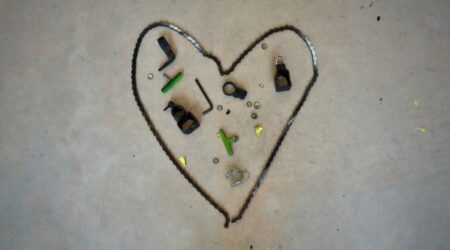
As our project, we transformed the “simple” act of fixing a bicycle into an introspective investigation of the concept of care and its implications. Within a few weeks, we collaboratively tried to bring life into a neglected two-wheeler. In all repairing sessions we took time for self-reflection, retracing the steps, thoughts and actions performed. By this, we tried to dig out the underlying patterns that are connected to our doing. Analysing the process brought up several challenges and questions. Is fixing the bike an act of care that we do towards the object, or towards ourselves? How are gender roles manifested in our actions? Can you break something as an act of maintenance? Is it necessary to receive care in order to perform an act of care? Is the concept of care an act of pure altruism, completely unrelated to any kind of end or return? Are we doing this project merely out of selfishness aimed at completing an assigned task to get a grade? What does care mean for us? Finally, the reflections were transformed into a video installation that will be displayed this Friday.
(No) More Stretch Please – Manifesto for (In)Flexibility
By Paula Kristiāna Veidenbauma, Jannik Kastrup, Luca Liese Ritter
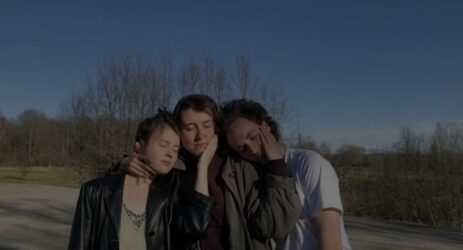
We have a problem. At the Estonian Academy of Arts, a room can become an exhibition hall, a hallway can be turned into a conference center, any of the concrete walls—into galleries, waiting for the next vernissage to start. The architecture of EKA’s new building bears unending potential imaginaries, designed as always hybrid, always adaptable, and ever-changing. But how much space is left for flexibility in the program designs? And how does it show in the program implementation? Does the immaterial system behind the space provide a flexible support mechanism for students when in need or is flexibility ultimately a false promise, disguising flaws within the university’s structure?
The project examines the relationship between the flexible-oh-so-flexible working environment and culture at the university and the systematic framework of program structures at the EKA Faculty of Architecture. Grounded in our own experience, observations and private stories of students, at times faced with the limits of the flexibility, The Manifesto for (In)Flexibility is both an attempt to gain visibility of the invisible sufferings at an institution deeply grounded within the landscape of neoliberal academia, as well as a manual on how to resist the institutional normalisation of overworking. Presented in a form of a performative reading, the project includes movement practices addressing space exploration, testing the limits of the flexibility of one’s body and those of the space, thinking, where would they meet.

the door stop
By Nora Soo, Kush Badhwar, Khadeeja Farrukh
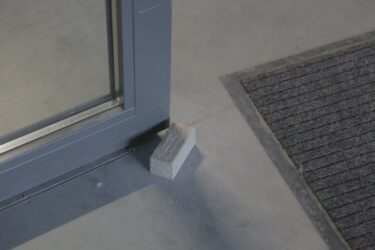
The new building for the Estonian Academy of Arts (EKA), made amongst the remains of an old textile factory, was opened for use in 2018. The ground for a newer EKA building is being prepared behind the current building. A new green sign, with the signature EKA typeface was erected to mark this site within the last week.
Part of the process of envisioning, designing and producing new and newer EKA buildings, is the narrativisation and historicisation of these sites, most visibly undertaken as marketing materials, often to attract new students to the university. the door stopis a zine that seeks to broaden narrativisation and historicisation of EKA through the observation, documentation, story-telling and imaginations of the building from the student perspective, with particular attention to use, care, appropriation, resistance, creative misuse, image-based intervention and other forms that fall outside of the intentions of the architect(s) and hegemony of the institution.
Composed of photography, text and sketches, the door stop, though limited to the perspective of three students, hopes to document the overlooked and the ephemeral; foster care, interest and engagement in the space amongst students + their future generations; and to possibly influence change in the production of further EKA buildings.
Looking for Action
By Christian Hörner, Paulina Schroeder, Nabeel Imtiaz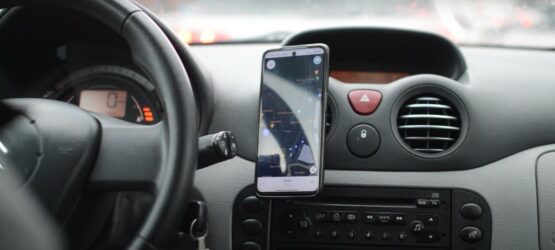
Techno-Ecologies of Care emerge throughout the entanglements between the courier, his mobile phone, the car, the food, and many other things, affording moments of caring for and about in this system of provision of life-sustaining matter. Our project tries to present illuminating documentation of the everyday work of a bolt food courier. These urban workers are often invisible, working under a highly neoliberal regime of platform capitalism. Also, they are directly exposed to novel algorithmic means which manage their routes and govern the relationship between couriers, restaurants, and customers which make up the urban space of food delivery. Our video emerged out of the empirical practice of participant observation and represents a methodical mixture of interview/conversation and active participation in the process of food delivery. We aim to shed light on the internalities of food delivery in the sense of capturing the potentially boring details of everydayness as proposed by Susan Leigh Star in her essay “The Ethnography of Infrastructure”.
Posted by Kaija-Luisa Kurik — Permalink
Urban Ethnography – Technoecologies of care. Final presentations
Friday 29 April, 2022
Urban Studies
Taking technoecologies of care in (hard or soft) urban infrastructure as a starting point, the Urban Ethnography course (tutors: Agata Marzecova and Hanna Husberg) uses ethnographic strategies to make perceptible interdisciplinary phenomena that cannot be described from a disciplinary perspective. During the course the participants are encouraged to develop collaborative research projects that explore boundary approaches to ethnography by critically employing creative and artistic research methods in the research process, as well as for conveying their research results.
Whereas ecology can be understood as a science of relatedness between things, beings and processes that make up urban nature or urban space, technoecologies allows an analysis of the entanglement of technologies and natures, and draws attention to how the materialisation of nature is always and already a mediated phenomenon. Subsequently, addressing care through its technoecologies allows for a prism through which human, non-human and technological elements are treated not as separate entities but as interrelated aspects of care, maintenance and repair.
The finals will start at 14:00 with four group presentations by students (abstracts below). This will be followed by a presentation starting at 17.30 by our external reviewer, Swedish-Brazilian artist, researcher, writer and Senior Lecturer in Media and Communication Studies at Södertörn University (Stockholm), Isabel Löfgren. Lögfgren often works in collaboration with artistic collectives and art institutions considering issues in visual, gender, social and environmental justice and her research interests include cultural politics, aesthetics, and the philosophy of migration and diaspora in the fields of contemporary art, media philosophy, and media activism.
Facebook event can be found HERE.
Pimp my bike
By Martina Maria Semenzato, Leonardo Improta , Paul Jochen Simon

As our project, we transformed the “simple” act of fixing a bicycle into an introspective investigation of the concept of care and its implications. Within a few weeks, we collaboratively tried to bring life into a neglected two-wheeler. In all repairing sessions we took time for self-reflection, retracing the steps, thoughts and actions performed. By this, we tried to dig out the underlying patterns that are connected to our doing. Analysing the process brought up several challenges and questions. Is fixing the bike an act of care that we do towards the object, or towards ourselves? How are gender roles manifested in our actions? Can you break something as an act of maintenance? Is it necessary to receive care in order to perform an act of care? Is the concept of care an act of pure altruism, completely unrelated to any kind of end or return? Are we doing this project merely out of selfishness aimed at completing an assigned task to get a grade? What does care mean for us? Finally, the reflections were transformed into a video installation that will be displayed this Friday.
(No) More Stretch Please – Manifesto for (In)Flexibility
By Paula Kristiāna Veidenbauma, Jannik Kastrup, Luca Liese Ritter

We have a problem. At the Estonian Academy of Arts, a room can become an exhibition hall, a hallway can be turned into a conference center, any of the concrete walls—into galleries, waiting for the next vernissage to start. The architecture of EKA’s new building bears unending potential imaginaries, designed as always hybrid, always adaptable, and ever-changing. But how much space is left for flexibility in the program designs? And how does it show in the program implementation? Does the immaterial system behind the space provide a flexible support mechanism for students when in need or is flexibility ultimately a false promise, disguising flaws within the university’s structure?
The project examines the relationship between the flexible-oh-so-flexible working environment and culture at the university and the systematic framework of program structures at the EKA Faculty of Architecture. Grounded in our own experience, observations and private stories of students, at times faced with the limits of the flexibility, The Manifesto for (In)Flexibility is both an attempt to gain visibility of the invisible sufferings at an institution deeply grounded within the landscape of neoliberal academia, as well as a manual on how to resist the institutional normalisation of overworking. Presented in a form of a performative reading, the project includes movement practices addressing space exploration, testing the limits of the flexibility of one’s body and those of the space, thinking, where would they meet.

the door stop
By Nora Soo, Kush Badhwar, Khadeeja Farrukh

The new building for the Estonian Academy of Arts (EKA), made amongst the remains of an old textile factory, was opened for use in 2018. The ground for a newer EKA building is being prepared behind the current building. A new green sign, with the signature EKA typeface was erected to mark this site within the last week.
Part of the process of envisioning, designing and producing new and newer EKA buildings, is the narrativisation and historicisation of these sites, most visibly undertaken as marketing materials, often to attract new students to the university. the door stopis a zine that seeks to broaden narrativisation and historicisation of EKA through the observation, documentation, story-telling and imaginations of the building from the student perspective, with particular attention to use, care, appropriation, resistance, creative misuse, image-based intervention and other forms that fall outside of the intentions of the architect(s) and hegemony of the institution.
Composed of photography, text and sketches, the door stop, though limited to the perspective of three students, hopes to document the overlooked and the ephemeral; foster care, interest and engagement in the space amongst students + their future generations; and to possibly influence change in the production of further EKA buildings.
Looking for Action
By Christian Hörner, Paulina Schroeder, Nabeel Imtiaz
Techno-Ecologies of Care emerge throughout the entanglements between the courier, his mobile phone, the car, the food, and many other things, affording moments of caring for and about in this system of provision of life-sustaining matter. Our project tries to present illuminating documentation of the everyday work of a bolt food courier. These urban workers are often invisible, working under a highly neoliberal regime of platform capitalism. Also, they are directly exposed to novel algorithmic means which manage their routes and govern the relationship between couriers, restaurants, and customers which make up the urban space of food delivery. Our video emerged out of the empirical practice of participant observation and represents a methodical mixture of interview/conversation and active participation in the process of food delivery. We aim to shed light on the internalities of food delivery in the sense of capturing the potentially boring details of everydayness as proposed by Susan Leigh Star in her essay “The Ethnography of Infrastructure”.
Posted by Kaija-Luisa Kurik — Permalink

